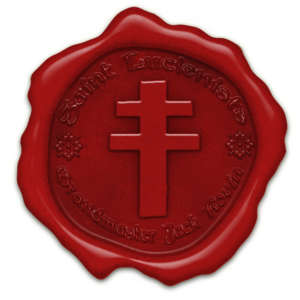Order of Saint Lucien
| ||||||||||||||||||||||||||
The Poor-Fellow Soldiers of Horen and Saint Lucien of Savoie (Flexio: Pauperes commilitones Horeni et Sanctus Lucianus), also known as the Poor-Fellow Soldiers of Saint Lucien of Savoie, was a Lucienist military order formed by High Pontiff Lucien II of the Church of the True Faith. Formed through a papal bull, the Order was active between 1447-1459.
During the height of its power, the Order of Saint Lucien acted as an overall force for the Church of the True Faith, often guarding clergymen and participating in wars against non-humans. They enjoyed a great deal of success in expanding the Church's influence to the various Elven dominions, and spent much time fighting the minions of Setherien throughout Anthos. The Order was not without its human enemies, often finding themselves in brawls with followers of the Raevir Orthodoxy. This would eventually lead to the Order's disbandment in 1459 in the Proclamation of Demilitarization after the theses of Basil of Sabris and Simon of Khazav to dissolve the Church gained popular attention.
Contents
History
Rise
The Order of Saint Lucien was established in early 1447 by High Pontiff Lucien II primarily response to his waning abilities to enforce church doctrine throughout the Kingdom of Oren. Looking for a body of soldiers to provide general protection to clergymen and the Pontiff himself, all of whom were often the victims of petty bandits and raiders, Lucien II found a small band of religious mercenaries known as the Vandorian Order. These fresh soldiers, lead by a former man-at-arms of the Order of the White Rose, had proven martial prowess at the Siege of Shadow Castle during the Tarus Rebellion, where their last minute fortifications of the ill-equipped castle and valiant hold on the northern flank against a charge of Teutonic Sariants helped to win the battle. After saving Lucien II from a band of robbers in Abresi, they were formally established as the Church's military wing, with Jack Rovin being knighted as the first Holy Ser since the Exodus along with his son Voron Rovin, and Rymeul Elendil, an Adunian lord who had joined the Vandorian Order. Being formed of mainly ethnic Kaedreni, the men of the order took up the name Poor-Fellow Soldiers of Saint Lucien of Savoie after Velwyn Ashford, the only Kaedreni saint. With this, they became the authority on the Lucienist sect of the True Faith, which had long been in decline since the fall of the First Empire.
From the Black Marsh, the order is reported to have grown rapidly in size, swelling to over 1,000 soldiers in its first few months of establishment. This is partially due to its liberal acceptance of repentant sinners, particularly in allowing criminals and heretics a last effort at absolute redemption. Naturally, the Lucienists began to expand back into Kaedrin, establishing a small fortress upon the side of a ravine, and started to carry out conversion activities in the former realms that made up Malinor. Zealous but respective of the Elven religions, the order began a successful process of converting non-Humans to the Church of the True Faith, and even began programs to recruit some of these non-humans into local auxiliary chapters. After a particularly gruesome attack by cultists of Iblees and Setherian, the Lucienists began to crackdown upon their existence in their realm of influence. With the blessings of Lion DeNurem and Relgard Sintel, leaders of the Conclave, the order conducted numerous raids and searches to root out a growing cultist insurgency. Many of the elves who were found to be conspiring with the insurgency were crucified around the area, and the Lucienists were not bashful in collecting necklaces of Elf ears from those who actively worked against them.
Involvement in the Oren-Urguan War
...
Lucienist-Raevir War
...
Decline
TBC
The Fringe Wars
TBC
Restoration of the Holy Orenian Empire
Dissolution
TBC
Organization
The Order of Saint Lucien was organized as a monastic order and wielded considerable influence throughout Anthos and the Fringe because of its numerous holdings scattered about multiple countries. The most basic forts and lodgings were referred to as Bailiwicks, which often held anywhere from five to fifty men. Each bailiwick was appointed a titular bailiff to oversee the institution. After a group of bailiwicks had been installed in an area, one would be chosen for expansion. This resulted in the creation of a commandery, which would be run by a Master-and-Commander, who would further control the local bailiffs. Each Master-and-Commander reported periodically to the Grand Master. Each commandery was then placed under a religious jurisdiction known as a priory, which would be overseen by a prior sent by the High Pontiff. While Master-and-Commanders held most of the authority in the day-to-day operations of their soldiers, Priors often held administrative dominance.
The primary commander of the Order of Saint Lucien was located in the Black Marsh, a particularly cold swamp that separated Abresi from the northern Kingdom of Herendul. While most of the knowledge regarding Lucienist information was lost in the flood of Anthos, it is commonly known that there was a baliwick established on the ruins of Kaedrin in the Westerlands, and a commandery placed upon the ruins of the Old Cloud Temple.
Ranks
The ranking structure of the Order of Saint Lucien was split into three categories: High Command, Low Command, and Enlisted Men. High Command consisted exclusively of the Grand Master's chosen advisors, known as the Inner Council of Bailiffs, of whom were required to be Knights of Justice. The main advisor to the Grandmaster was known as the Grand Commander, and acted oftentimes as the face of the order. The Grand Chancellor was responsible for handling most of the administrative paperwork throughout the order, as well as acting as a public liaison. The Grand Prior, appointed by the High Pontiff, handled most of the Order's interior religious efforts. The Grand Conservator handled all logistical works throughout the order, handling all means of income and expense and equipment allocation.
The Low Command consisted of all of the knights of the order who were not in the Inner Council. There were three types of Lucienist Knights: Knights of Justice, Knights of Obedience, and Knights of Devotion. Knights of Justice were considered to be the most pious of their counterparts, taking up vows to chastity, poverty, and obedience. They adorned a red cloak upon their white mantle to signify the devotion of their life to God. Knights of Obedience were not as pious as the Knights of Justice, as they were only required to take a vow of poverty and obedience. Furthermore, Knights of Devotion only took a vow of poverty, and were often restricted to landed lords who worked part-time with the order. Both Knights of Obedience and Devotion wore grey cloaks. From this body of knights rose two officers, the Knight Commander and Knight Constable; the former of which acted strictly as a direct authority of the knights and the latter of which as his assistant.
The Enlisted Men consisted of three subunits: the Sergeants, the Brothers, and the Initiates. Sergeants were often the grizzled veterans who had worked their way to become non-commissioned officers over their counterparts. A Sergeant-at-Arms was promoted from them to be the lead enlisted man. Brothers referred to general members of the order, but was often used as a catch-all phrase for everyone in the order. Initiates were those who had not taken vows to become full-fledged members of the order.
Tenants
The Order of Saint Lucien held two different sets of tenants dictating the behavior of their members. The first set, unique to the order, was known as the Rhodesian Creed. The creed consisted of four virtues which were symbolic to the four arms of the Rhodesian Cross:
Prudence,
Justice,
Fortitude,
and Temperance
And eight beatitudes which were symbolic of the eight points on the Rhodesian Cross:
Spiritual Joy,
To Weep Over Thy Sins,
To Love Justice,
To Be Sincere and Pure of Heart,
To Live Without Malice,
To Humble Thyself to Those who Injure Thee,
To Suffer Persecution.
In addition, the Lucienists adopted the ancient Vander Code, a set of warrior values that would go on to shape the various chivalric codes of the later Orenian Empires. The Vander Code consisted of twelve points:
To fear the Creator and maintain His Church,
To serve the liege lord in valour and faith,
To refrain from the wanton giving of offence,
To live by honour and for glory,
To despise pecuniary reward,
To obey those placed in authority,
To guard the honour of fellow Vanders,
To keep faith,
To at all times to speak the truth,
To persevere to the end in any enterprise begun,
To never to refuse a challenge from an equal,
To never to turn the back upon a foe.
Held Relics
Legacy
...

